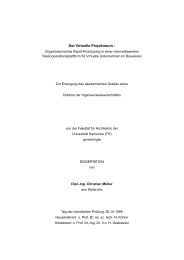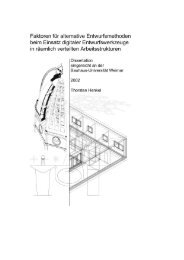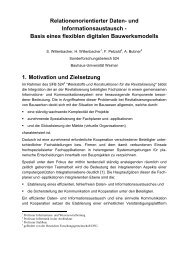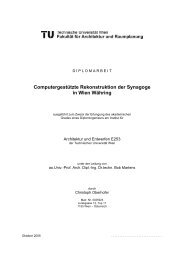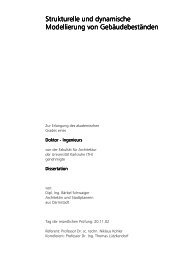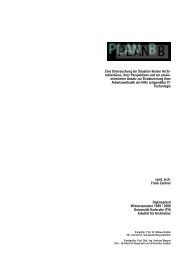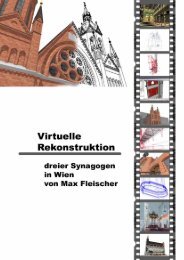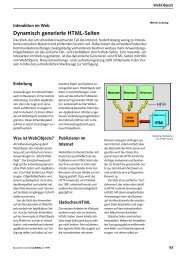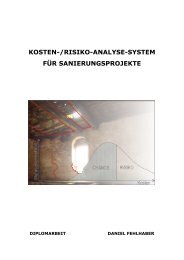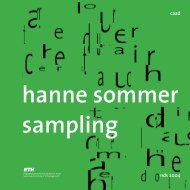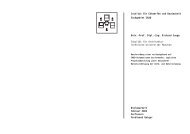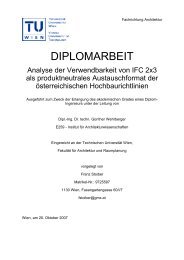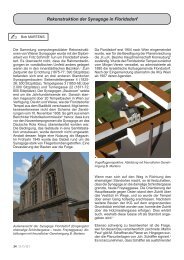- Seite 1: Fachgebiet Computer Aided Architect
- Seite 5: Abstrakt (dt.) Entwurfsaufgaben kö
- Seite 10 und 11: II Inhalt 2.2.12 Otto Wagner ......
- Seite 12 und 13: IV Inhalt 4.5 Überlegenheit des Me
- Seite 14 und 15: VI Inhalt 6.4 Anforderungen an die
- Seite 16 und 17: VIII Inhalt 8.5.3 Geschossübergrei
- Seite 19: für: Kiki Moritz Markus Marie Soph
- Seite 23 und 24: Zusammenfassung Diese Arbeit kann a
- Seite 25 und 26: 1 Einführung „Der Architekt übt
- Seite 27 und 28: 1.1 Motivation 5 Folgt man Thomas M
- Seite 29 und 30: 1.1 Motivation 7 Wie der Computer m
- Seite 31 und 32: 1.2 Ausgangssituation heute 9 � W
- Seite 33 und 34: 1.2 Ausgangssituation heute 11 Abb.
- Seite 35 und 36: 1.2 Ausgangssituation heute 13 Prod
- Seite 37 und 38: 1.3 Ein CAAD-Arbeitsplatz gestern,
- Seite 39 und 40: 1.3 Ein CAAD-Arbeitsplatz gestern,
- Seite 41 und 42: 1.3 Ein CAAD-Arbeitsplatz gestern,
- Seite 43 und 44: 1.3 Ein CAAD-Arbeitsplatz gestern,
- Seite 45 und 46: 1.4 Hemmnisse, CA(A)D im Entwurfsst
- Seite 47 und 48: 1.4 Hemmnisse, CA(A)D im Entwurfsst
- Seite 49 und 50: 1.6 Nutzen des frühen Einsatzes de
- Seite 51 und 52: 1.7 Fragen, die sich stellen 29 Rou
- Seite 53 und 54: 2.1 Einleitung 31 2.1.1 Architektur
- Seite 55 und 56: 2.1 Einleitung 33 Abb. 2.3: Figurie
- Seite 57 und 58:
2.1 Einleitung 35 Abb. 2.7: Etienne
- Seite 59 und 60:
2.2 Architekturtheorie 37 Abb. 2.10
- Seite 61 und 62:
2.2 Architekturtheorie 39 Abb. 2.13
- Seite 63 und 64:
2.2 Architekturtheorie 41 Abb. 2.14
- Seite 65 und 66:
2.2 Architekturtheorie 43 Innen und
- Seite 67 und 68:
2.2 Architekturtheorie 45 Abb. 2.16
- Seite 69 und 70:
2.2 Architekturtheorie 47 Palladio
- Seite 71 und 72:
2.2 Architekturtheorie 49 Natur. Ar
- Seite 73 und 74:
2.2 Architekturtheorie 51 Einsicht,
- Seite 75 und 76:
2.2 Architekturtheorie 53 Abb. 2.19
- Seite 77 und 78:
2.2 Architekturtheorie 55 Abb. 2.20
- Seite 79 und 80:
2.2 Architekturtheorie 57 Der küns
- Seite 81 und 82:
2.2 Architekturtheorie 59 Abb. 2.27
- Seite 83 und 84:
2.2 Architekturtheorie 61 Abb. 2.30
- Seite 85 und 86:
2.2 Architekturtheorie 63 Abb. 2.32
- Seite 87 und 88:
2.3 Definition von Architektur im 2
- Seite 89 und 90:
2.3 Definition von Architektur im 2
- Seite 91 und 92:
2.3 Definition von Architektur im 2
- Seite 93 und 94:
2.4 Neue Materialien führen zu neu
- Seite 95 und 96:
2.4 Neue Materialien führen zu neu
- Seite 97 und 98:
2.5 Musik und Architektur - Proport
- Seite 99 und 100:
2.5 Musik und Architektur - Proport
- Seite 101 und 102:
2.5 Musik und Architektur - Proport
- Seite 103 und 104:
2.6 Typologie in der Architektur 81
- Seite 105 und 106:
2.7 Fazit 83 lität zu formulieren.
- Seite 107 und 108:
2.7 Fazit 85 Zusammengefasst: � D
- Seite 109 und 110:
3.2 Begriffe Architekt und Architek
- Seite 111 und 112:
3.2 Begriffe Architekt und Architek
- Seite 113 und 114:
3.2 Begriffe Architekt und Architek
- Seite 115 und 116:
3.2 Begriffe Architekt und Architek
- Seite 117 und 118:
3.3 Der architektonische Entwurf 95
- Seite 119 und 120:
3.3 Der architektonische Entwurf 97
- Seite 121 und 122:
3.3 Der architektonische Entwurf 99
- Seite 123 und 124:
3.3 Der architektonische Entwurf 10
- Seite 125 und 126:
3.3 Der architektonische Entwurf 10
- Seite 127 und 128:
3.4 Kreativität 105 Abb. 3.9: Norm
- Seite 129 und 130:
3.4 Kreativität 107 Aussage machte
- Seite 131 und 132:
3.4 Kreativität 109 vor bloßem Pr
- Seite 133 und 134:
3.5 Die Macht der Intuition 111 Abb
- Seite 135 und 136:
3.6 Entwurfsmentalitäten 113 Abb.
- Seite 137 und 138:
3.6 Entwurfsmentalitäten 115 Abb.
- Seite 139 und 140:
3.7 Entwerfen 117 Abb. 3.23: Paul S
- Seite 141 und 142:
3.7 Entwerfen 119 Abb. 3.27: A sket
- Seite 143 und 144:
3.7 Entwerfen 121 Abb. 3.32: Der sc
- Seite 145 und 146:
3.8 Mathematik zur Entwurfsunterst
- Seite 147 und 148:
3.9 Architektonisches Entwerfen mit
- Seite 149 und 150:
3.10 Architekt und Architektur im W
- Seite 151 und 152:
3.10 Architekt und Architektur im W
- Seite 153 und 154:
3.12 Fazit 131 gungen zu stellen.
- Seite 155 und 156:
3.12 Fazit 133 � Kreativität in
- Seite 157 und 158:
Abb. 4.1: A system of human functio
- Seite 159 und 160:
4.2 CAAD-Systeme: zu schwer zu erle
- Seite 161 und 162:
4.2 CAAD-Systeme: zu schwer zu erle
- Seite 163 und 164:
4.3 Unser Gedächtnisspeicher 141 A
- Seite 165 und 166:
4.3 Unser Gedächtnisspeicher 143
- Seite 167 und 168:
4.4 Überlegenheit und Grenzen von
- Seite 169 und 170:
4.4 Überlegenheit und Grenzen von
- Seite 171 und 172:
4.6 Computersysteme im Bauwesen heu
- Seite 173 und 174:
4.6 Computersysteme im Bauwesen heu
- Seite 175 und 176:
4.7 Künstliche Intelligenz 153 4.7
- Seite 177 und 178:
4.7 Künstliche Intelligenz 155 Sys
- Seite 179 und 180:
4.7 Künstliche Intelligenz 157 Abb
- Seite 181 und 182:
4.7 Künstliche Intelligenz 159 Das
- Seite 183 und 184:
4.7 Künstliche Intelligenz 161 Abb
- Seite 185 und 186:
4.7 Künstliche Intelligenz 163 die
- Seite 187 und 188:
4.7 Künstliche Intelligenz 165 All
- Seite 189 und 190:
4.8 Fazit 167 4.8 Fazit � Die men
- Seite 191 und 192:
4.8 Fazit 169 � Künstliche Intel
- Seite 193 und 194:
5.1 Einleitung 171 „herauslesen
- Seite 195 und 196:
5.2 Verschiedene Modelle des Entwur
- Seite 197 und 198:
5.3 Shapegrammars, Regeln und Gramm
- Seite 199 und 200:
5.3 Shapegrammars, Regeln und Gramm
- Seite 201 und 202:
5.3 Shapegrammars, Regeln und Gramm
- Seite 203 und 204:
5.3 Shapegrammars, Regeln und Gramm
- Seite 205 und 206:
5.3 Shapegrammars, Regeln und Gramm
- Seite 207 und 208:
5.3 Shapegrammars, Regeln und Gramm
- Seite 209 und 210:
5.4 Case-based Reasoning (CBR) 187
- Seite 211 und 212:
5.4 Case-based Reasoning (CBR) 189
- Seite 213 und 214:
5.5 Analyse und Synthese 191 Nach P
- Seite 215 und 216:
5.6 Gebäudemodelle (GMs) 193 Abb.
- Seite 217 und 218:
5.6 Gebäudemodelle (GMs) 195 Abb.
- Seite 219 und 220:
5.6 Gebäudemodelle (GMs) 197 Abb.
- Seite 221 und 222:
5.6 Gebäudemodelle (GMs) 199 Abb.
- Seite 223 und 224:
5.6 Gebäudemodelle (GMs) 201 welch
- Seite 225 und 226:
5.8 Der Planungsprozess im Bauwesen
- Seite 227 und 228:
5.9 CAAD-Systeme sind Kreativitäts
- Seite 229 und 230:
5.10 Intuitives User Interface - Vo
- Seite 231 und 232:
5.10 Intuitives User Interface - Vo
- Seite 233 und 234:
5.10 Intuitives User Interface - Vo
- Seite 235 und 236:
5.11 Kritik am Status quo 213 Abb.
- Seite 237 und 238:
5.12 Allgemeine Problemstellung der
- Seite 239 und 240:
5.13 Was heutige Anwendungsprogramm
- Seite 241 und 242:
5.15 Was fehlt, um CAAD für die fr
- Seite 243 und 244:
6.1 Das Gebäudemodell (GM) 221 ges
- Seite 245 und 246:
6.3 Anforderungen an die qualitativ
- Seite 247 und 248:
6.3 Anforderungen an die qualitativ
- Seite 249 und 250:
6.4 Anforderungen an die quantitati
- Seite 251 und 252:
6.5 Anforderungen an die Benutzersc
- Seite 253 und 254:
6.5 Anforderungen an die Benutzersc
- Seite 255 und 256:
6.5 Anforderungen an die Benutzersc
- Seite 257 und 258:
6.6 Hardware 235 6.6.2 Direkt besch
- Seite 259 und 260:
7 Chancen künftiger CAAD-Systeme E
- Seite 261 und 262:
7.1 Ansätze zu Alternativen 239 Ab
- Seite 263 und 264:
7.1 Ansätze zu Alternativen 241 7.
- Seite 265 und 266:
7.1 Ansätze zu Alternativen 243
- Seite 267 und 268:
7.1 Ansätze zu Alternativen 245 de
- Seite 269 und 270:
7.2 Benutzerschnittstelle (UI) 247
- Seite 271 und 272:
7.2 Benutzerschnittstelle (UI) 249
- Seite 273 und 274:
7.4 Hardware 251 da deren Pflege un
- Seite 275 und 276:
7.5 Fazit 253 7.4.4 Vernetzung Die
- Seite 277 und 278:
Abb. 8.1: Rome’s Mosque, modellie
- Seite 279 und 280:
8.1 Das Entwurfsmodul 257 Abb. 8.3:
- Seite 281 und 282:
8.2 Das Viewsystem 259 Abb. 8.6: Ko
- Seite 283 und 284:
8.2 Das Viewsystem 261 Abb. 8.10: E
- Seite 285 und 286:
8.2 Das Viewsystem 263 Abb. 8.15: S
- Seite 287 und 288:
8.3 Qualitative Entwurfsunterstütz
- Seite 289 und 290:
8.3 Qualitative Entwurfsunterstütz
- Seite 291 und 292:
8.3 Qualitative Entwurfsunterstütz
- Seite 293 und 294:
8.3 Qualitative Entwurfsunterstütz
- Seite 295 und 296:
8.3 Qualitative Entwurfsunterstütz
- Seite 297 und 298:
8.3 Qualitative Entwurfsunterstütz
- Seite 299 und 300:
8.3 Qualitative Entwurfsunterstütz
- Seite 301 und 302:
8.4 Softwareassistenten unterstütz
- Seite 303 und 304:
8.4 Softwareassistenten unterstütz
- Seite 305 und 306:
8.4 Softwareassistenten unterstütz
- Seite 307 und 308:
8.4 Softwareassistenten unterstütz
- Seite 309 und 310:
8.5 Quantitative Entwurfsunterstüt
- Seite 311 und 312:
8.5 Quantitative Entwurfsunterstüt
- Seite 313 und 314:
8.7 Vorschlag für ein GM-Programm,
- Seite 315 und 316:
8.7 Vorschlag für ein GM-Programm,
- Seite 317 und 318:
8.7 Vorschlag für ein GM-Programm,
- Seite 319 und 320:
8.7 Vorschlag für ein GM-Programm,
- Seite 321 und 322:
8.7 Vorschlag für ein GM-Programm,
- Seite 323 und 324:
8.7 Vorschlag für ein GM-Programm,
- Seite 325 und 326:
8.8 Eine intuitive Bedieneroberflä
- Seite 327 und 328:
8.8 Eine intuitive Bedieneroberflä
- Seite 329 und 330:
8.8 Eine intuitive Bedieneroberflä
- Seite 331 und 332:
8.8 Eine intuitive Bedieneroberflä
- Seite 333 und 334:
8.8 Eine intuitive Bedieneroberflä
- Seite 335 und 336:
8.9 Hardware 313 Abb. 8.84: Die Gr
- Seite 337 und 338:
8.9 Hardware 315 Abb. 8.87: Cursorb
- Seite 339 und 340:
8.9 Hardware 317 Abb. 8.88: Freies
- Seite 341 und 342:
8.9 Hardware 319 Abb. 8.92: Direkte
- Seite 343 und 344:
8.9 Hardware 321 Abb. 8.94: Mit dem
- Seite 345 und 346:
8.10 Vor- und Nachteile semantische
- Seite 347 und 348:
8.11 Woran der Einsatz von CAAD in
- Seite 349 und 350:
Fazit Die Bedeutung der Verwendung
- Seite 351:
Fazit 329 Reflexionen zu lassen, um
- Seite 354 und 355:
332 Literaturverzeichnis Büchner 2
- Seite 356 und 357:
334 Literaturverzeichnis Herr et al
- Seite 358 und 359:
336 Literaturverzeichnis Milizia 17
- Seite 360:
338 Literaturverzeichnis Simon und



